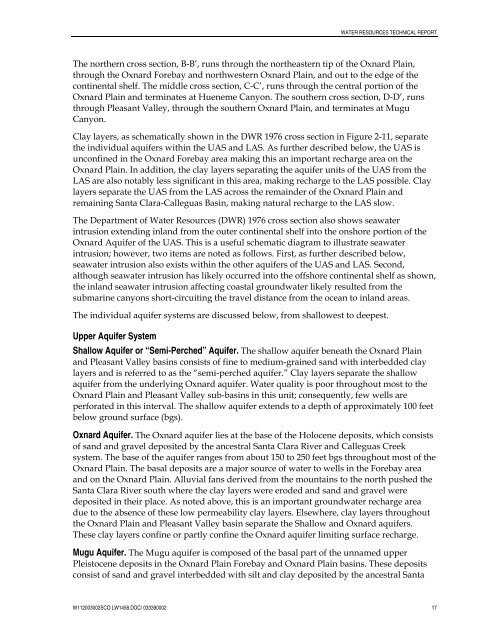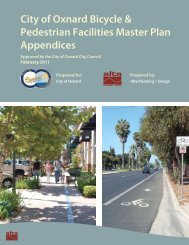View File - Development Services - City of Oxnard
View File - Development Services - City of Oxnard
View File - Development Services - City of Oxnard
Create successful ePaper yourself
Turn your PDF publications into a flip-book with our unique Google optimized e-Paper software.
WATER RESOURCES TECHNICAL REPORTThe northern cross section, B-B’, runs through the northeastern tip <strong>of</strong> the <strong>Oxnard</strong> Plain,through the <strong>Oxnard</strong> Forebay and northwestern <strong>Oxnard</strong> Plain, and out to the edge <strong>of</strong> thecontinental shelf. The middle cross section, C-C’, runs through the central portion <strong>of</strong> the<strong>Oxnard</strong> Plain and terminates at Hueneme Canyon. The southern cross section, D-D’, runsthrough Pleasant Valley, through the southern <strong>Oxnard</strong> Plain, and terminates at MuguCanyon.Clay layers, as schematically shown in the DWR 1976 cross section in Figure 2-11, separatethe individual aquifers within the UAS and LAS. As further described below, the UAS isunconfined in the <strong>Oxnard</strong> Forebay area making this an important recharge area on the<strong>Oxnard</strong> Plain. In addition, the clay layers separating the aquifer units <strong>of</strong> the UAS from theLAS are also notably less significant in this area, making recharge to the LAS possible. Claylayers separate the UAS from the LAS across the remainder <strong>of</strong> the <strong>Oxnard</strong> Plain andremaining Santa Clara-Calleguas Basin, making natural recharge to the LAS slow.The Department <strong>of</strong> Water Resources (DWR) 1976 cross section also shows seawaterintrusion extending inland from the outer continental shelf into the onshore portion <strong>of</strong> the<strong>Oxnard</strong> Aquifer <strong>of</strong> the UAS. This is a useful schematic diagram to illustrate seawaterintrusion; however, two items are noted as follows. First, as further described below,seawater intrusion also exists within the other aquifers <strong>of</strong> the UAS and LAS. Second,although seawater intrusion has likely occurred into the <strong>of</strong>fshore continental shelf as shown,the inland seawater intrusion affecting coastal groundwater likely resulted from thesubmarine canyons short-circuiting the travel distance from the ocean to inland areas.The individual aquifer systems are discussed below, from shallowest to deepest.Upper Aquifer SystemShallow Aquifer or “Semi-Perched” Aquifer. The shallow aquifer beneath the <strong>Oxnard</strong> Plainand Pleasant Valley basins consists <strong>of</strong> fine to medium-grained sand with interbedded claylayers and is referred to as the “semi-perched aquifer.” Clay layers separate the shallowaquifer from the underlying <strong>Oxnard</strong> aquifer. Water quality is poor throughout most to the<strong>Oxnard</strong> Plain and Pleasant Valley sub-basins in this unit; consequently, few wells areperforated in this interval. The shallow aquifer extends to a depth <strong>of</strong> approximately 100 feetbelow ground surface (bgs).<strong>Oxnard</strong> Aquifer. The <strong>Oxnard</strong> aquifer lies at the base <strong>of</strong> the Holocene deposits, which consists<strong>of</strong> sand and gravel deposited by the ancestral Santa Clara River and Calleguas Creeksystem. The base <strong>of</strong> the aquifer ranges from about 150 to 250 feet bgs throughout most <strong>of</strong> the<strong>Oxnard</strong> Plain. The basal deposits are a major source <strong>of</strong> water to wells in the Forebay areaand on the <strong>Oxnard</strong> Plain. Alluvial fans derived from the mountains to the north pushed theSanta Clara River south where the clay layers were eroded and sand and gravel weredeposited in their place. As noted above, this is an important groundwater recharge areadue to the absence <strong>of</strong> these low permeability clay layers. Elsewhere, clay layers throughoutthe <strong>Oxnard</strong> Plain and Pleasant Valley basin separate the Shallow and <strong>Oxnard</strong> aquifers.These clay layers confine or partly confine the <strong>Oxnard</strong> aquifer limiting surface recharge.Mugu Aquifer. The Mugu aquifer is composed <strong>of</strong> the basal part <strong>of</strong> the unnamed upperPleistocene deposits in the <strong>Oxnard</strong> Plain Forebay and <strong>Oxnard</strong> Plain basins. These depositsconsist <strong>of</strong> sand and gravel interbedded with silt and clay deposited by the ancestral SantaW112003002SCO LW1458.DOC/ 033390002 17
















